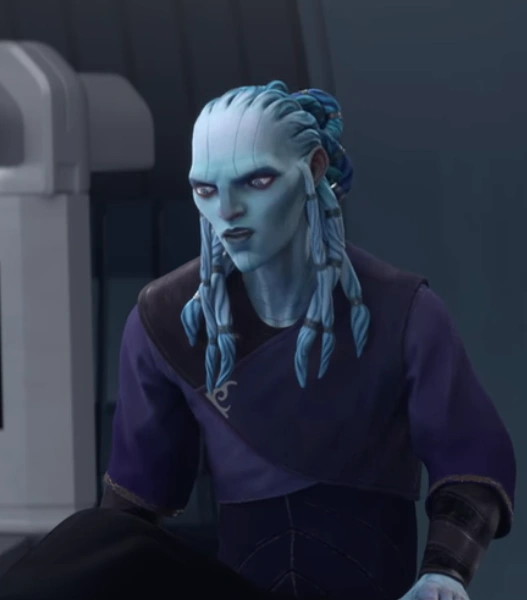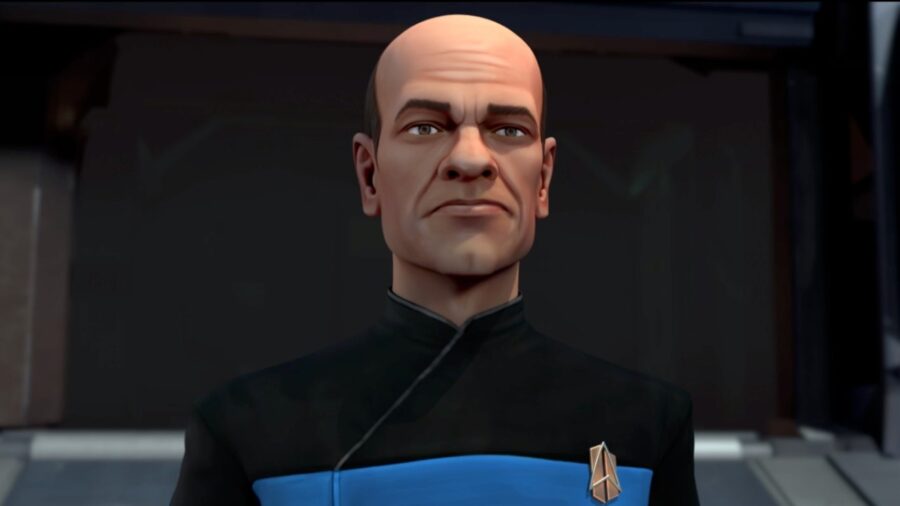The title, an inversion of the series’ name, indicates the focus in this episode on the bridge crew. It is the flip side of and a play on TNG: “Lower Decks”, an episode focused on the lower deckers when the series is mainly about the bridge crew.
Whatever Stardate it is, it’s Halloween on Cerritos. Although Picard seemed to be unfamiliar with the holiday in TNG: “The Big Goodbye”, McCoy makes reference to it in TOS: “Catspaw”. Mariner used to dress as Toby the Targ for Halloween (LD: “Crisis Point”) and Boimler dressed once as Christopher Pike (SNW: “Those Old Scientists”). As a bit of trivia, the registry number for the USS Discovery, NCC-1031, was allegedly chosen by Bryan Fuller because he loved Halloween.
V’Ger is the antagonist in TMP, and Mariner quotes the Ilia probe from the movie’s climax. This season, V’Ger joined the ever crowded starship battle in the opening credits.
Boimler’s mustache has finally joined up with his goatee, although his muttonchops have yet to. His line about how the lower deckers are the stars of the show while the commanders fade into the background is a meta comment on LD itself.
Steve Stevens makes another appearance, this time a speaking one, and he appears to be assisting Freeman now rather than following Ransom around as he used to.
Barnes is a Trill Operations Officer who used to date Rutherford (LD: “Second Contact”). The most memorable example of a pathogen causing devolution is from TNG: “Genesis”, where a mutated T-cell allowed dormant genes to be transferred from one person to another. Nurse Ogawa, in particular, devolved into an ape-like form.
The Clickets, an insectoid race that treated thanks as a hostile gesture, first appeared in LD: “Veritas”.
Shax’s hallucination reminds me of the multiple Shaxes Rutherford thinks about when he’s trying to figure out how Shax returned from the dead (LD: “We’ll Always Have Tom Paris”).
Freeman says she doesn’t want the buhgoon defecating all over the hull. Coincidentally enough, the Cambodian word for “toilet” is bangkon, which is pronounced similarly.
Billups talks about Cordry Rocks in the ceiling which Ransom complains always fall on him when they take damage. This is the first time anyone in-universe has ever acknowledged the rock-like material that flies about whenever consoles explode since TNG. Billups starts to technobabble that that “their non-centrosymmetry disrupts the charge leptons in the isolinear pathways of the main deflector, which then causes…” but is cut off. The rocks may be named after Marian Cordry, who works at the Star Trek Archive & Library at Paramount Global.
The Professor is a Grazerite, the same species as Federation President Jaresh-Inyo (DS9: “Homefront”). Ransom calls the buhgoon “space cows”. They are an extremophile, much like tardigrades are known as “water bears”. Tardigrades in the Trek universe can grow to much larger sizes than their microscopic terrestrial counterparts, of course (DIS “Choose Your Pain”).
Delta Shift, formerly the nemeses of our Beta Shift, has been assigned the task of bringing a buhgoon on board. The auburn-haired ensign is Moxy, who first appeared in LD: “Terminal Provocations” (from her forehead markings she could be a Trill). The one blaming “Ensign Friendly” is Karavitus, who also first appeared in “Terminal Provocations”. The burly male is Hans Federov, better known as “Towel Guy”, who was finally given a first name in LD: “The Stars at Night”. “Friendly” is Ensign Castro (from Beta Shift), who first appeared in LD: “Envoys” and is also voiced by Gabrielle Ruiz (T’Lyn).
We see the shuttles Kings Canyon, Yosemite II, Joshua Tree II and Redwood, named after Californian National Parks. The original Yosemite shuttle crashed in LD: “Where Pleasant Fountains Lie” and Joshua Tree in LD: “Grounded”.
Tempasa was a settlement on Bajor, outside of which was located a Cardassian heavy weapons unit. Kira and her resistance cell raided and destroyed it (DS9: “Ties of Blood and Water”), although her father died while she was away on the mission. Shax’s flashback to Tempasa explains how he got his right eye scarred.
Nurse Westlake is named after Chris Westlake, composer for LD’s soundtrack. He first appeared in “Second Contact” and has been around throughout the show, although this is the first time we’ve heard him speak. Westlake talks about viruses that can make “everyone sing or whatever”. While not viral-based, a singing plague did strike in SNW: “Subspace Rhapsody”.
The PADD schedule notes Barnes’ sousaphone recital, a fertility event, and Winger Bingston Jr’s One Man Show, “The United Federation of Characters”, last seen performed in LD: “Moist Vessel”.
The buhgoon have a natural cloaking ability. Other species with biological invisibility include the Jem’hadar (DS9: “The Jem’hadar”), Tosk (DS9: “Captive Pursuit”), Xaheans (ST: “Runaway”), the itronok of Trill (DIS: “Jinaal”). Technically, the Devidians as well, since their natural state is being out of phase (TNG: “Time’s Arrow”).
Bingston’s line “Stuck out of phase, like Geordi and Ro wandering alone,” refers to the events of TNG: “The Next Phase”. The USS Manticore is a Manticore-class destroyer in Star Trek Online, but Bingston’s line implies this is an Oberth-class vessel of that name. Stevens wakes up clapping, much like Riker does in TNG: “Schisms”.
The alien ship is of Clicket design, last seen in “Veritas”.
“Dumber than Fletcher,” says one of the Delta Shifters. Fletcher was a dangerously incompetent officer who was eventually transferred off Cerritos (“Terminal Provocations”). His stint on the USS Titan lasted only six days, after which he was demoted and sent back to Earth.
Ransom has a habit of working out when trying to make decisions (LD: “No Small Parts”).
Ensign Meredith first appeared in LD: “Room for Growth” and is voiced by Charlotte Nicdao, whose Aussie accent some might recognize from Apple TV+’s Mythic Quest.
The Bynars are a race of cybernetically enhanced humanoids who are gifted in programming (TNG: “11001001”). They last appeared on LD in LD: “Old Friends, New Planets”, and made an appearance in PRO: “Ascension”.
The Grazerite Professor (whose name is Zurkel) is revealed as a Clicket, in a reveal that reminds me of when the Visitors in V were exposed as reptilian rather than humanoid. It’s also reminiscent of the Bug coming out of its human disguise in the first Men in Black movie and the Raxacoricofalapatorians from Doctor Who.
As noted above, Freeman dealt with the Clickets in “Veritas”, which makes Zurkel’s infuriation understandable.
Billups’ situation is reminiscent of Spock’s death scene in ST II, where he too was dying in a tube, except that opening it would release radiation, not coolant.
Billups’ first name, Andarithio (his friends call him “Andy”) was revealed in “Veritas”. The unnamed cadet first appeared at the end of LD: “wej Duj”.
“Zo”, or Admiral Alonzo Freeman, is Carol Freeman’s husband and Mariner’s father. We last saw him in “Old Friends, New Planets”. The holodeck is set to Paris, and is similar to the view from the Cafe Des Artistes seen in TNG: “We’ll Always Have Paris”.
Shax is drinking out of a purple Highwave Hotjo 14 oz travel mug used in DS9. The purple ones were custom colored for the show, but they are currently available from Highwave (US and Australia shipping only) if you want them, in Deep Space Purple.




